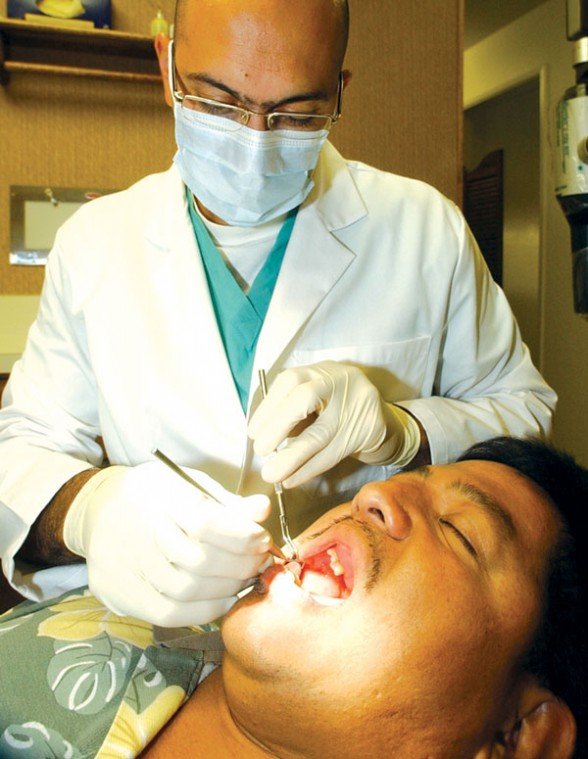Periodontitis, one of the most common forms of gum disease, is
often symptomless and invisible to the untrained eye, but it isn’t
harmless.
Periodontitis, one of the most common forms of gum disease, is often symptomless and invisible to the untrained eye, but it isn’t harmless.
New research links periodontal disease to health problems that go well beyond tooth loss. It could also contribute to heart disease, diabetes and low infant birth weights, though the reasons for these connections are not yet clear, according to periodontist Dr. Mark Fagan.
“It’s not a pure cause-and-effect, but it’s been shown that they can happen together,” said Fagan, an adjunct clinical professor at the University of California, San Francisco School of Dentistry. “The important thing is to make sure you’re doing mechanical cleaning, such as brushing and flossing, and seeing a dentist on a regular basis for cleanings.”
There are several types of gum disease – the major cause of tooth loss in adults – but all of them start with bacteria, according to the California Dental Association. Gum disease affects nearly nine in 10 Americans, but few of them know it. Each day, bacteria-infested plaque deposits build up on teeth, and the human body must fight them off. Most people help this process along by brushing regularly, but when these deposits settle below the gumline, they’re harder to reach.
The bacteria that finds its way under the gumline begins to breed, irritating the gums, which may become inflamed or may bleed when brushed, according to the CDA. However, people who floss and see the dentist regularly are often able to keep this minor infection, known as gingivitis, from going any further.
Left untreated, though, gingivitis progresses into a more serious and permanent condition known as periodontitis, said Dr. Ehsan Rezvan of Gilroy. This happens when the gum infection progresses far enough that regular flossing and dental tools can no longer reach it. Instead, pockets of bacteria accumulate more than three millimeters below the gumline, forcing gum tissue away from the hardened surface of the tooth and leading to bleeding or recession of the gumline, he said.
Dentists may treat moderate cases of periodontitis with deep cleanings and root planing, reaching well below the gumline to clean away bacteria pockets while patients are under local anesthesia, said Rezvan.
“Eventually, if you don’t do anything, it will lead into bone loss because the bacteria will attack the tooth and the bone that holds it,” said Rezvan.
Such severe cases may require surgery, to open the gumline, remove bacteria growth and reshape the bone.
“In the worst cases, you’ll see 85 to 90 percent bone loss,” said Rezvan. “That would be a point where we would have to take the teeth, but in many cases, we can reshape the bone and even do bone grafts to help a person keep their teeth.”
Some forms of periodontitis are more aggressive than others, so immediate treatment is recommended, especially in young patients, according to Rezvan, and some forms may be treatable with a combination of dental care and oral antibiotics, said Fagan.
Genetics play a role for some periodontal patients, but in many cases, other factors can contribute to the development of periodontal disease.
Smoking, chewing tobacco and maintaining poor dietary or hygiene habits can be especially damaging to gum health, but other factors such as poor tooth alignment, badly fitted bridges, defective fillings and tooth clenching or grinding habits can also contribute to the development of gum disease. These risk factors are especially important to curb in children who may one day want braces.
“You have to be free of gum disease before you can have braces,” said Dr. Tommy Tong, a Gilroy-based orthodontist. “If you’re in active orthodontic treatment where the teeth are moving, your gum disease will accelerate. Braces by themselves will not cause gum disease, but they make oral hygiene more difficult, so if a patient is more susceptible to periodontal disease, they may get it, too.”
To keep a mouth in tip-top shape, patients need to do more than brush and floss, said Fagan. They need to know how to do it correctly.
“The proper way to floss is to wrap the floss around the tooth and move gently up and down along the tooth surface, not see-saw back and forth,” said Fagan
Fagan also counsels patients to brush carefully using a soft toothbrush. Hold the brush at a 45-degree angle with half the bristles brushing the gumline and half the bristles brushing the tooth, he said. Move the brush in small circles along the teeth and gums rather than brushing back and forth, he added. The American Dental Association does not offer a recommended brushing time, but many electric toothbrushes are on two-minute timers, the brushing time most often recommended by dentists, according to Sonicare.com.
More Information
For more information on caring for your teeth, visit the California Dental Association’s Web site at www.cda.org. If you do not have a regular dentist, contact the Santa Clara County Dental Society. They provide a free dental referral service for community members who call (408) 289-1480 or visit www.sccds.org.
For more information on choosing a dental professional in San Benito County, visit the California Healthy Families Web site at www.healthyfamilies.ca.gov. The site allows potential patients to search for a local dentist by name, gender, specialty, language or location. Users can also research available plans to find out which plan will work best for them.













